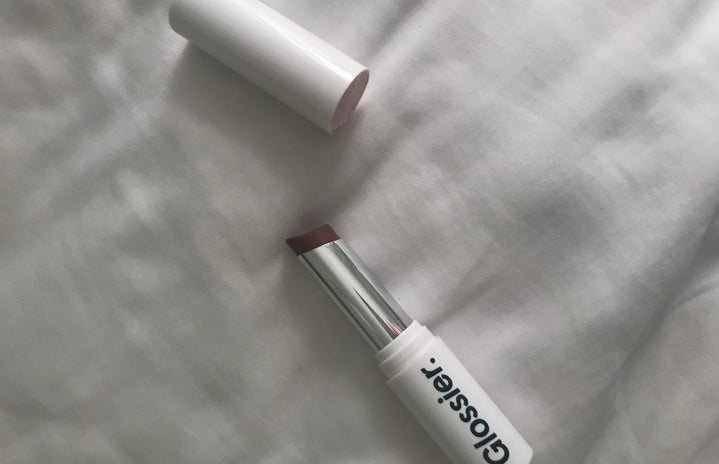Glossier’s origin story is different from many other beauty brands. Emily Weiss, founder of Glossier, got her start at Vogue where she created her blog “Into the Gloss” in 2010. “Into the Gloss” featured beauty recommendations from the it-girls of the moment, and people were easily able to access what beauty products they were actually using. This series of her blog was called “Top Shelf” and was the originator of the term “shelfie.” Weiss would go over to her subject’s houses, sit on their bathroom floor, and talk to them about their beauty routine. “Top Shelf” felt very intimate: like you’re chatting with friends about makeup products. In an age before we had access to the beauty gurus we have today, it allowed the average person to get a sneak peek of what the it girls of the time were using. Readers were also encouraged to post their own “shelfie”, propelling the idea that beauty was not just a necessary labor, it was a form of self expression. The community that “Into the Gloss” cultivated was a club-like feel where whatever brand you identified with was your tribe, and this culture would continue with the launch of Glossier.
When the idea of Glossier was teased on “Into the Gloss”, their Instagram account already had 13,000 followers, without having any products. Glossier launched in 2014 with just four products: a moisturizer, face mist, skin tint and a lip balm. They also released a gray sweater at launch that Karlie Kloss was photographed in. When the baby pink hoodie with Glossier’s logo on it was released, 10,000 people joined the waitlist to buy it.
Glossier’s popularity lies in its simplicity. Every product focuses on enhancing natural beauty, rather than covering up imperfections. At the time of the company’s launch, people were starting to move away from heavier makeup, and wanted a fresher, cleaner finish. Glossier has set themselves apart from their competitors in this sense, and also in how they marketed their brand. Most makeup brands advertised an unattainable picture of luxury and beauty, like Urban Decay or Anastasia Beverly Hills, while Glossier on the other hand was targeted to the average person. Their ads featured normal, everyday people. Their products have a very sleek and simple look to them.
Another deliberate choice in Glossier’s branding strategy was their choice to start out as a direct- to-consumer brand. While you can now find Glossier in Sephora, you used to only be able to buy their products directly from their website. This created a more intimate relationship between the consumer and the brand; the customer felt like they were being directly catered to.
Everything Glossier has done to build their brand has been an intentional choice to create a large group of dedicated followers. The Glossier “community” tends to engage in hyper consumerism;everything Glossier releases, fans will buy. Even though Glossier does carry a lot of good products, it’s less about the quality of the makeup and more about the brand itself. The way that Glossier has curated their image and lifestyle that they present in a way that is irresistible to many.
Thus, I must mention the cult following. Glossier fans want the lifestyle and aesthetic that Glossier presents, rather than the product. When I say they’ll buy anything with Glossier on it, I mean anything. Glossier has a section of their website where they sell Glossier branded clothes and other knick knacks. Two years ago they came out with a cookie cutter in the shape of their G logo. To an outsider, this decision seems puzzling, but people bought this cookie cutterit because when they subscribe to the Glossier fan club, they subscribe to hyper consumerism and collect these products just because they’re limited edition or they want to own everything Glossier has to offer. Every season, Glossierthey releases a new sticker that comes for free with every purchase, and people want to collect these stickers so badly that they’ll buy from Glossier just so they can add the sticker to their collection.
Glossier’s online community is the cornerstone to their success. They launched as an only online direct to consumer brand, so they had to build up a community of people who would keep coming back, because you wouldn’t be able to stumble upon their products in Sephora or Ulta. I took a deep dive into their community to further understand the mentality. The Glossier Subreddit was a no-brainer for me: a corner of the internet where more than 51,000 members congregate to talk about all things Glossier. What I found only reaffirmed my beliefs. The Subreddit posts were all glowing praise for Glossier and all of their products, and if you ever said anything negative about them, you would be inundated with downvotes. You see many people engaging in hyper consumerism, spending hundreds of dollars on products or merch at one time, solely because they’re limited edition. When you take away the logo and all the hype around the brand, their products aren’t revolutionary or life changing for the most part. I myself enjoy their blushes and concealer, and I’ve tried many of their other products, but they’re not something I couldn’t live without, and I certainly don’t need a Glossier tote bag or passport holder to display that I like the brand.
You won’t see a cult following like Glossier’s for any other beauty brand. The reason why so many people flock to Glossier and become so devoted to them is because they want to belong to this community. Normal people wouldn’t buy a cookie cutter or a mug from their favorite beauty brand, but the Glossier devotees want to display that they belong to this group, that the company is what they identify themselves with.


